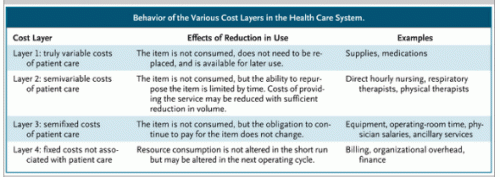Short piece in the latest NEJM claiming that clinical quality improvements will typically fail to result in bottom line cost savings due to the cost structure of health care.
The explanation lies in the cost structure of the typical health care setting. Its management and organization create a rigid cost structure that is relatively insensitive to small changes in patient volume, resource use, or the severity of patients’ health conditions.
They lay out 4 cost layers and discuss the result of reduced use of resources in that layer that are due to clinical quality improvements (fewer readmissions, lessened volume to investigate a given condition, small improvements in patient health, etc).
Layer 1 “truly variable costs” (not using something that can be used on another patient) can reduce costs in the short run, and improved efficiency of administrative functions (fixed costs not associated with patient care, layer 4) can do so in the long run. However, there are bounds to how much savings due to quality improvements in these two layers can be realized.
Reductions in use in the other two layers (semivariable costs, like nursing and other labor) and (semifixed, like expensive technology) will not typically result in bottom line cost savings due to quality improvements per the piece, primarily because of the timing and cost structure of health care provision. If you don’t order another scan, the machine still must be paid for and the nurse and the tech to run the machine can’t be shifted into another activity easily, or at all. Layers 2 and 3 seem to be inherent attributes of health care (labor intensive and lots of expensive equipment) and thus hard to change, at least in the short run, which is the essence of their claims that it will be difficult to realize cost savings from clinical quality improvements that reduce certain types of health care use.
I need to think a bit more about this piece, but it is an interesting breakdown of “cost layers.” We know that we have quality as well as cost problems and both need to be addressed. If improving quality could also lower costs that would be great, but this piece claims that outcome will be very hard to realize due to the current cost structure of health care in the U.S.
update: Jeff Levin-Scherz also has a post on this paper from a few days ago.
*******
Stephen S. Rauh, M.B.A., C.F.A., Eric B. Wadsworth, Ph.D., C.P.A., William B. Weeks, M.D., M.B.A., and James N. Weinstein, D.O. The Savings Illusion — Why Clinical Quality Improvement Fails to Deliver Bottom-Line Results. NEJM 2011;111:1662.
DT


